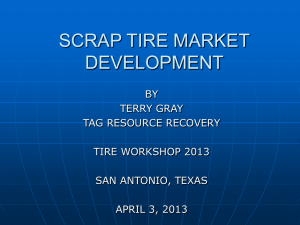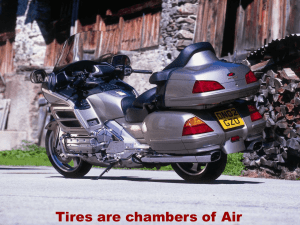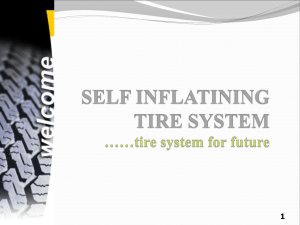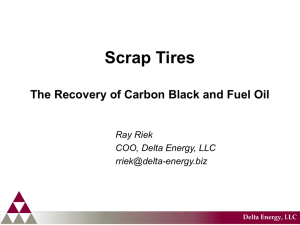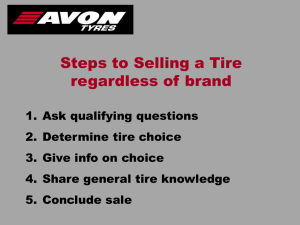Tires
advertisement
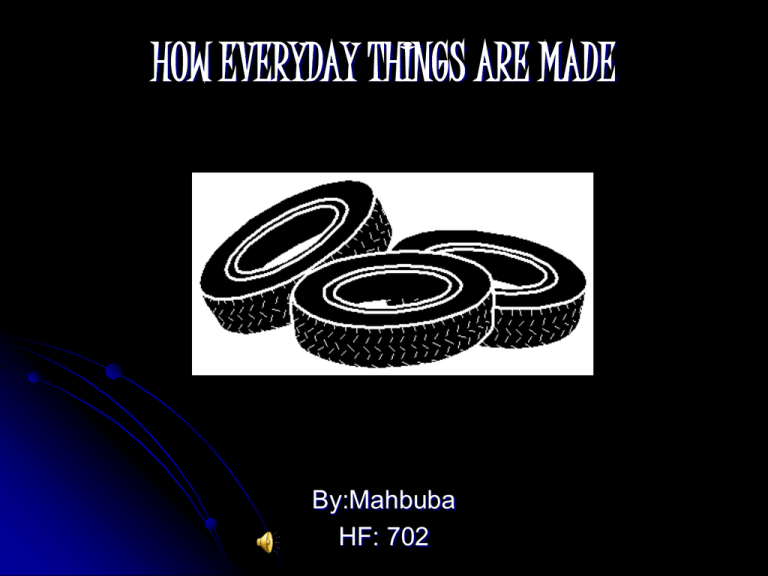
HOW EVERYDAY THINGS ARE MADE By:Mahbuba HF: 702 About Tires Tires are ring-shaped parts, that are either pneumatic or solid (which include rubber, metals and plastic composites), that fit tightly around wheels to protect them and enhance their performance and function. Pneumatic tires are used on many types of vehicles, such as motorcycles, bicycles, cars, trucks, and aircraft. Tires enable better vehicle performance by providing traction,( traction is friction allowing movement), braking, steering, and load support. Tires form an extreme flexible cushion between the vehicle and the pavement, which smooth out shock and makes for a comfortable ride. That is generally what tires are. Design • • • • The basic main features of a passenger vehicle tire are the tread, the body with complete sidewalls, and the beads. The tread is the accelerated pattern in direct contact with the road. The body of the tire supports the tread and gives the tire its own specific shape. The beads are rubber-covered, metal-wire bundles that hold the tire in its place on the wheel. Now computer systems play a pretty major role in tire design. Intricate analysis software depending on years of test data permit tire engineers to simulate the performance of tread design and other design parameters. The software also creates a three-dimensional color image of a possible tire design and it calculates the effects of dissimilar stresses on the anticipated tire design. Computer simulations save lots of money for tire manufacturers because they don’t need to spend money on test tires and failures. As well as the computer creating tests of tread design and tire body construction, computers can also replicate the effects of different types of rubber components and compounds. In a primitive passenger car tire, diverse types of rubber may be used in different parts of the tire. One rubber mixture may be used in the tread for good grip on the road in cold weather; another compound may be used to give increased firmness in the tire sidewalls. When the tire engineers are completely satisfied with computer studies of a new type of tire, manufacturing engineers and skilled tire assemblers work with the designers to produce tire prototypes for testing. After design and manufacturing engineers are fully satisfied with the fresh tire design, tire factories begin mass production of the new tire. Materials Extraction And Materials Processing Rubber is the genuine main raw material used in manufacturing tires, and both natural and synthetic rubber are used. Natural rubber is found in the bark of the rubber tree, Hevea Brasiliensis, as a milky liquid. To produce the raw rubber used in tire manufacturing, the liquid latex is mixed with varieties of acids that cause the rubber to solidify. Hot presses squeeze out all excess water and form the rubber into many sheets, and then the sheets are dried in very tall smokehouses, pressed into enormous bales, and they are shipped to tire factories all around the globe. Synthetic rubber is produced from the polymers that are found in crude oil. The other primary ingredient in tires are carbon black. Carbon black is a fine, soft powder created when crude oil or natural gas is burned with a limited quantity of oxygen, causing incomplete ignition and creating a large amount of well soot. A lot of carbon black is required for manufacturing tires that rail cars transport and huge silos preserve the carbon black at the tire factory until it is needed. Other chemicals such as Sulfur are also used in tires. When mixed with rubber and then heated, certain chemicals, produce specific tire distinctiveness such as high friction and but low mileage, for a racing tire- a high mileage but lower friction. Specific chemicals keep the rubber flexible while it is being shaped into a tire also while other chemicals protect the rubber from the ultraviolet radiation in sunshine. Manufacturing First stage of tire manufacturing is gathering all the raw materials and formulating rubber compounds. All the materials are then mixed together in a huge blender, called Banburys. After the mixing process is completed a gum like material forms. This material is then cut into different strips. These strips will make the sidewalls and other portions of the tire. The main body of the tire is manufactured using fabricated rubber. Polyester, nylon and rayon are the fabrics then used. But mostly Polyester is used. Another ring like component is used to make a tire, which is called tire bead. Steel wires of high tensile are worked with to make the tire bead. Radial tires are created in a cylindrical tire-building machines. After the making of the tire, it passes through a part assembling process. Tires are assembled from the inside out. The inner line of the tire is made of exactly two layers of synthetic rubber. Then another double layer of poly fabric is pasted onto it. Then follows two strips of apexes to harden the area. Then two chafer strips are pasted. Then automatic rollers press all the parts together. It helps the parts to bind well. After an inspection the tire goes for curing process. In the curing process the tire is heated up to all the way until 300ºF for 12-25 minutes. It gives the tire a proper shape. Then it passes through another inspection, which includes an X-ray session. If there is any fault, the X-ray session detects it. After the inspection the tire is ready to roll. That is how tires are manufactured. Packaging And Distributing In order for people to be able to use tires they need to receive them first. The tires need to be packaged and distributed before any use. The first step is to get the tires packaged. This is done by: ♦ The center caps on wheels, are secured with tape and other strong substances. A loose cap can irreparably damage a wheel’s finish during shipping. ♦ Foam sheets are placed on the face of wheels and all cardboard rounds are layered. The tires are wrapped tightly with tape a minimum of 6 times. The tape is crisscrossed. ♦ The bead protectors are slideably inserted inside of the bead portions of the tire and are retained in position by a plurality of elastic tension members. ♦ Addressed shipping label(s) are attached clearly and/or UPS call tag(s) are attached to each individual package. ♦ An RA# is written next to a foresaid label and/or UPS call tag on EVERY package. ♦ Once the tires are packaged, they are ready to be sent to distribution centers, retail outlets or other types of locations. The delivery is done with transportation by planes, trucks or rail/train. USE Tires are key to everyday transportation use. They provide a cover for wheels. A vehicle will not run smoothly without tires. Tires are protection to wheels. Here are some tips to prolong the life of tires: 1.) Have a wheel alignment on your tires - Proper wheel alignment gives you a fine grip. Also it will save your money by increasing gas mileage and preventing unnecessary punctures and tear on your tires, steering system and suspension. 2.) Rotate tires periodically- Rotating your tires will prolong its life by reducing uneven tread wear. Also, it reduces the risk of getting into a sudden accident due to spontaneous tire failure. 3.) Make sure that your tires are not under inflated – Having proper air pressure provides the following benefits: • reduces the risk of getting into an accident by providing better handling and control • reduces uneven tire wear • reduces fuel consumption and exhaust emissions. You should purchase the air pressure gauge, which cost a smaller amount than $5 at any car parts retail store, so you can check the air pressure once a month. 4.) Proper wheel balancing – Retaining your wheel assembly in balance ensures a comfortable ride and prolongs the life of your tires and suspension. END OF LIFE The end of life stage during a product’s life cycle is when product is of no more use and it is either disposed, recycled or reused in an other way. Tires are recycled when they are no longer suitable for use on the road. Tires are one of the most re-used materials because rubber is very resilient. There are four main types of recycling tires: • Ultrasound recycling • Tire Pyrolysis • Microwave Recycling • Mechano-Chemical Recycling Sometimes tire owners do not take the liberty of getting their tires recycled so they just end up getting the tires landfill disposed. The careless stockpiles and illegal dumping is harmful in many ways. Stockpiles can create fires, these fires pollute the air. Scrap tires can be become breeding ground for mosquitoes carrying diseases. So therefore, non-recycled tires can cause a health issue. IMPACT ON ENVIROMENT The following are the impacts on the environment that are caused in each of the life stages of a tire: • Design- Now a days tire engineers don’t have to worry about wasting rubber (which is wasting trees) or harming The environment by making many trial tires before their final design, because the computer is their to do everything for them. But before tire engineers would have to make several tires before they good get their final design, which would impact on the environment by killing trees for no agreeable reason. • Materials Extraction- This process harms the environment since objects such as rubber has to be created by cutting trees getting the milky liquid needed to create it. A great percentage of the waste caused by tires comes at the raw materials phase. Using recycled raw materials reduces the need for new raw materials. • Materials Processing- This process harms the environment because when making the milky liquid into rubber, the transition includes using hot presses that create smoke. This smoke pollutes the air. • Manufacturing- When the tire is getting made in the tire manufacturing factories, the tires that are getting Produced cause gas emission, that drastically effect the air. But now the gas emission being produced by the tire has been exceedingly reduced. • Packaging and Distribution- This process harms the environment because the Styrofoam put into the boxes to keep the tire in good shape are getting disposed on landfills and are ruining them. This can be reduced by making smaller boxes to lessen the use of Styrofoam. • Use- The affect of tire use on the environment is natural changes that are occurring within our climate, and have even had an impact on the overall health of many individuals. • End Of Life- This process causes the extreme most negative impacts on the environment. The disposed tires can easily catch fire and that smoke created pollutes the air extremely, it can also cause bad respiratorial diseases. The tire that start to decay become a great breeding ground for mosquitoes carrying diseases. Recycling also harms the environment because changing the rubber into a re-usable form creates bad emissions. BIBLIOGRAPHY 1. 2. 3. 4. 5. 6. 7. 8. 9. 10. http://en.wikipedia.org/wiki/Tires http://gestdoc.webmichelin.com/ http://www.dnr.state.wi.us/org/caer/cea/publications/clipart/gifs/tires1. gif http://en.wikipedia.org/wiki/Tire_recycling http://www.freepatentsonline.com/EP1322484.html http://www.freshpatents.com/Tire-design-methoddt20081211ptan20080302465.php http://en.wikipedia.org/wiki/Tire_manufacturing#Materials http://www.madehow.com/Volume-1/Tire.html http://en.wikipedia.org/wiki/Natural_rubber Golan, Asher (1990). The ATS technology and tires processing. Thermo Friction. -BOOK
